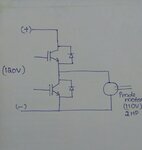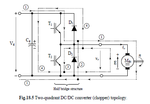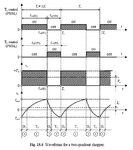francis29
Member level 5
Hi i am working on dc motor drive using half bridge. The circuit is attached with this. IGBT i am using is stgw30nc120hd and and switching frequency is 20khz i am giving complementary signals to high side and low side igbt with 5us dead time.
the problem is the high side igbt getting heated and sometimes component fails.
I am also attaching the output current and voltage waveform.
from what i have read about the 2 qudrant chopper this waveform is not matching.
Can you guys give me some idea what is going on
the problem is the high side igbt getting heated and sometimes component fails.
I am also attaching the output current and voltage waveform.
from what i have read about the 2 qudrant chopper this waveform is not matching.
Can you guys give me some idea what is going on



